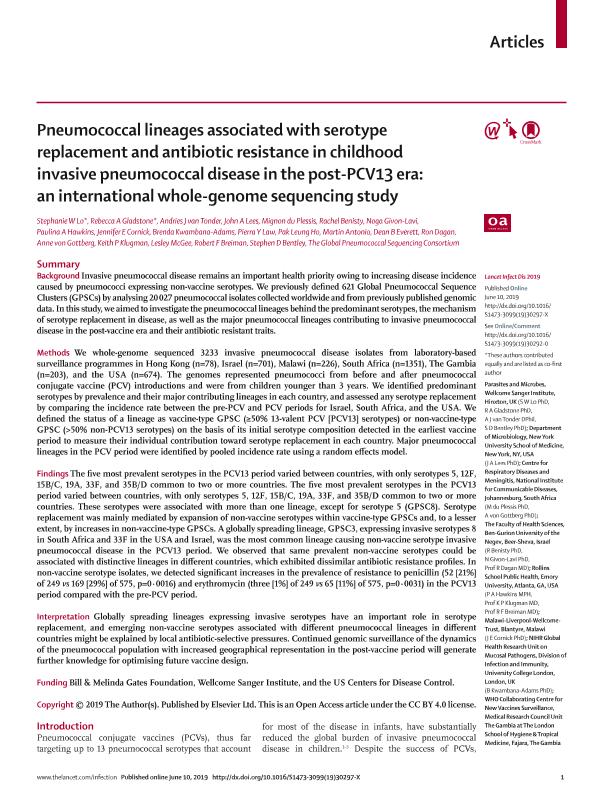Artículo
Pneumococcal lineages associated with serotype replacement and antibiotic resistance in childhood invasive pneumococcal disease in the post-PCV13 era: an international whole-genome sequencing study
Lo, Stephanie W.; Gladstone, Rebecca A.; van Tonder, Andries J.; Lees, John A.; du Plessis, Mignon; Benisty, Rachel; Givon Lavi, Noga; Hawkins, Paulina A.; Cornick, Jennifer E.; Kwambana Adams, Brenda; Law, Pierra Y.; Ho, Pak Leung; Antonio, Martin; Everett, Dean B.; Dagan, Ron; Von Gottberg, Anne; Klugman, Keith P.; McGee, Lesley; Breiman, Robert F.; Bentley, Stephen D.; Brooks, Abdullah W.; Corso, Alejandra; Davydov, Alexander; Maguire, Alison; Pollard, Andrew; Kiran, Anmol; Skoczynska, Anna; Moiane, Benild; Beall, Bernard; Sigauque, Betuel; Aanensen, David; Lehmann, Deborah; Faccone, Diego Francisco

Fecha de publicación:
07/2019
Editorial:
Elsevier Science Inc
Revista:
Lancet Infectious Diseases
ISSN:
1473-3099
Idioma:
Inglés
Tipo de recurso:
Artículo publicado
Clasificación temática:
Resumen
Background: Invasive pneumococcal disease remains an important health priority owing to increasing disease incidence caused by pneumococci expressing non-vaccine serotypes. We previously defined 621 Global Pneumococcal Sequence Clusters (GPSCs) by analysing 20 027 pneumococcal isolates collected worldwide and from previously published genomic data. In this study, we aimed to investigate the pneumococcal lineages behind the predominant serotypes, the mechanism of serotype replacement in disease, as well as the major pneumococcal lineages contributing to invasive pneumococcal disease in the post-vaccine era and their antibiotic resistant traits. Methods: We whole-genome sequenced 3233 invasive pneumococcal disease isolates from laboratory-based surveillance programmes in Hong Kong (n=78), Israel (n=701), Malawi (n=226), South Africa (n=1351), The Gambia (n=203), and the USA (n=674). The genomes represented pneumococci from before and after pneumococcal conjugate vaccine (PCV) introductions and were from children younger than 3 years. We identified predominant serotypes by prevalence and their major contributing lineages in each country, and assessed any serotype replacement by comparing the incidence rate between the pre-PCV and PCV periods for Israel, South Africa, and the USA. We defined the status of a lineage as vaccine-type GPSC (≥50% 13-valent PCV [PCV13] serotypes) or non-vaccine-type GPSC (>50% non-PCV13 serotypes) on the basis of its initial serotype composition detected in the earliest vaccine period to measure their individual contribution toward serotype replacement in each country. Major pneumococcal lineages in the PCV period were identified by pooled incidence rate using a random effects model. Findings: The five most prevalent serotypes in the PCV13 period varied between countries, with only serotypes 5, 12F, 15B/C, 19A, 33F, and 35B/D common to two or more countries. The five most prevalent serotypes in the PCV13 period varied between countries, with only serotypes 5, 12F, 15B/C, 19A, 33F, and 35B/D common to two or more countries. These serotypes were associated with more than one lineage, except for serotype 5 (GPSC8). Serotype replacement was mainly mediated by expansion of non-vaccine serotypes within vaccine-type GPSCs and, to a lesser extent, by increases in non-vaccine-type GPSCs. A globally spreading lineage, GPSC3, expressing invasive serotypes 8 in South Africa and 33F in the USA and Israel, was the most common lineage causing non-vaccine serotype invasive pneumococcal disease in the PCV13 period. We observed that same prevalent non-vaccine serotypes could be associated with distinctive lineages in different countries, which exhibited dissimilar antibiotic resistance profiles. In non-vaccine serotype isolates, we detected significant increases in the prevalence of resistance to penicillin (52 [21%] of 249 vs 169 [29%] of 575, p=0·0016) and erythromycin (three [1%] of 249 vs 65 [11%] of 575, p=0·0031) in the PCV13 period compared with the pre-PCV period. Interpretation: Globally spreading lineages expressing invasive serotypes have an important role in serotype replacement, and emerging non-vaccine serotypes associated with different pneumococcal lineages in different countries might be explained by local antibiotic-selective pressures. Continued genomic surveillance of the dynamics of the pneumococcal population with increased geographical representation in the post-vaccine period will generate further knowledge for optimising future vaccine design. Funding: Bill & Melinda Gates Foundation, Wellcome Sanger Institute, and the US Centers for Disease Control.
Palabras clave:
STREPTOCOCCAL
,
VACCINE
,
PCV13
,
RESISTANCE
Archivos asociados
Licencia
Identificadores
Colecciones
Articulos(SEDE CENTRAL)
Articulos de SEDE CENTRAL
Articulos de SEDE CENTRAL
Citación
Lo, Stephanie W.; Gladstone, Rebecca A.; van Tonder, Andries J.; Lees, John A.; du Plessis, Mignon; et al.; Pneumococcal lineages associated with serotype replacement and antibiotic resistance in childhood invasive pneumococcal disease in the post-PCV13 era: an international whole-genome sequencing study; Elsevier Science Inc; Lancet Infectious Diseases; 19; 7; 7-2019; 759-769
Compartir
Altmétricas



